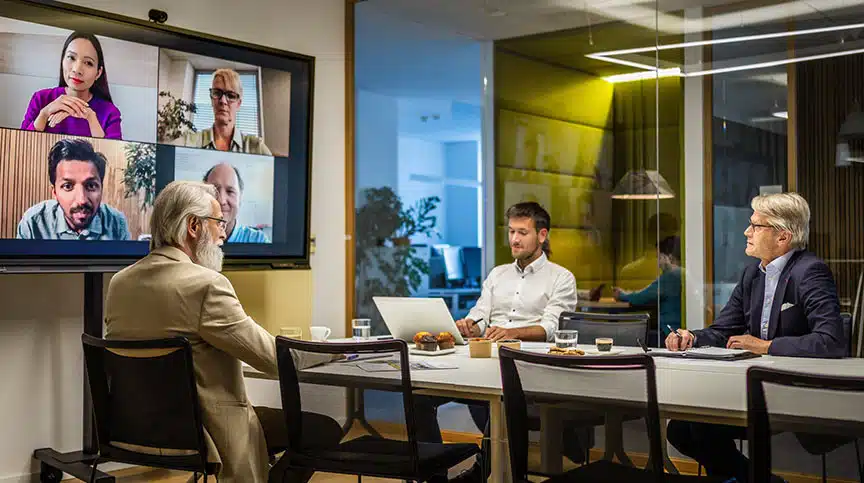How Reverse Mentoring Can Support Digital Transformation & Cross-Generational Collaboration
What’s reverse mentoring, and what makes it different from “regular” mentoring?
Reverse mentoring is when a junior team member establishes a professional relationship with a senior team member, exchanging knowledge, skills, and understanding.
On the other hand, our Handbook of Coaching in Organizations defines “regular” mentoring as “an experienced leader meeting with someone more junior to help him or her benefit from the greater experience.”
Many HR leaders will tell you that both types of mentoring at work can be beneficial, but one key way in which reverse mentoring can be especially helpful is driving organizational digital transformation.
That’s because digital transformation is sometimes less about the organization and the market as a whole than it is about the people who adopt data and leverage technology for better business results. Many businesses now have 4, and in some cases, 5 generations working side-by-side in the workplace, creating situations where knowledgeable senior practitioners may have decades of experience, yet need to update their skillsets and mindsets.
With reverse mentoring, senior leaders can learn data and technology skills from younger team members, many of them digital natives, to advance their own skills and improve outcomes for the organization.
Benefits of Reverse Mentoring
In the best mentoring relationships, both people learn.
Reverse mentoring is no different. When younger employees share their knowledge with more experienced workers, it boosts both groups’ level of understanding, communication, and collaboration.
Beyond flipping the traditional hierarchy, reverse mentoring can also facilitate other strategic organizational goals, such as increasing retention of millennial workers, fostering a more inclusive culture that values the contributions of all employees, and increasing collaboration across multiple generations in the workforce.
A senior executive who isn’t especially tech-savvy but is eager to be mentored by a colleague who’s a digital native can learn new technical skills, bringing greater efficiencies to the work and leveraging data-driven insights in decision-making. And many senior leaders report enjoying other benefits from collaborating closely with younger workers too — including becoming inspired or energized by their teammates’ passion, new thinking, and fresh perspectives.
A younger mentor gains things from the reverse mentoring arrangement as well — namely, exposure to other areas and departments in the organization, access to the potentially larger leadership network of their more experienced mentee, and a chance to broaden their perspective and strategic thinking skills.
Consider this example. A colleague in his late 50s explains how reverse mentoring came to help him: “I’d just completed an assignment and had come to realize I was behind the times. My industry was rapidly moving forward in micro-bytes of information and analytics, while I was still working with pen and paper. Quite simply, while my industry was transforming, I was not.
“I realized I had a choice: I could continue doing the work as I had been doing for the past 10 years, until my retirement in 10 more years. Or, I could learn the new technology. At my age and level in the organization, that meant I would be the ‘old dog learning new tricks.’ But I knew Option A was not for me.”
So, he joined a project team with an average age of 33 — and his younger teammates helped to get him up to speed on the new technologies and workflows he needed to understand.
2 Keys to a Successful Reverse Mentoring Partnership
Tips for Reverse Mentor Relationships
1. Be willing to learn.
For reverse mentoring to be effective, senior leaders must be humble enough to set aside their perceptions of authority and privilege brought on by age and experience for the benefits, knowledge, and guidance of someone younger.
The senior leader needs to make a conscious and intentional effort to find and work with a younger mentor. The senior member needs to be ready to learn, prepared to make mistakes, and willing to try something new, and open to new ideas. The senior leader must be willing to encourage innovation and create a safe space for learning.
If a senior manager is ready to do these things, then they’re ready for reverse mentoring. Our colleague emphasizes this point: “When I made my decision to learn about new systems and grow new technical abilities I didn’t have, I knew I needed to reach out to the younger and more digitally savvy leaders inside my group and show that I was truly asking to learn from them as a peer, not as a senior manager, their superior.”
2. Follow traditional guidelines — with a twist.
In a “normal” or traditional mentoring relationship, the responsibility for beginning and sustaining the relationship falls more on the senior member. Why? Because the junior member may not have the confidence to repeatedly reach out and set up meetings to talk or hold the senior member accountable.
As the relationship deepens, the responsibility becomes more shared, but success depends heavily on the more experienced leader to begin the momentum. Reverse mentoring is similar, and generally follows these guidelines:
- Agree on the purpose of your mentorship. This might be sharing skills around technology, data, information, insight, or even changing a mindset about privilege.
- Identify norms for the relationship. This should include how to communicate, when and where to meet, language (using informal terms as opposed to formal hierarchical terms), and most importantly, confidentiality.
- Establish and maintain specific times for contact. Mentoring research reflects that the best meetings are scheduled, yet informal. For senior leaders, this may mean getting out of the office or off the video call and considering non-traditional spaces to meet, such as coffee shops, bookstores, parks, or maker-spaces. Informal meetings allow the relationship to deepen through shared personal experiences.
- Understand when the reverse mentoring relationship is over — in other words, when the initial purpose is met and it’s time to move on to something else. At that point, you can determine whether to allow the relationship to move forward or go on hiatus. Some mentoring relationships may run for decades. Others end much sooner, after the initial purpose is achieved. It’s always best if both people are intentional about how it will go forward, and when it will wrap up.
Here’s the twist for reverse mentoring: Even in a reverse mentoring arrangement, the senior member still maintains the responsibility for beginning and sustaining the life of the relationship. This is for 2 reasons:
- The senior leader may be in the same generation as the junior member’s parents — this provides an implied authority that the senior leader must remain aware of, and sensitive to, in the relationship.
- The senior leader has the experience and expertise to begin and benefit from the relationship. While a reverse mentoring relationship benefits both parties, it primarily benefits the senior member, so the senior member should be responsible for beginning the relationship, establishing guidelines, and ensuring the junior member is as comfortable as possible in the relationship.
Our colleague references the success he experienced from reverse mentoring: “The acceptance that I needed to learn did not come easily, but I learned to trust my mentor and myself, and began to personally transform within my new environment. Thanks to my younger mentor, I finally learned the software that I needed to understand, and how to leverage the data it created, enabling me to make more effective, metrics-driven decisions for the organization.”
Who says experience is always the best teacher?
Ready to Take the Next Step?
Reverse mentoring can be a strategy that prepares senior leaders at your organization for leading digital transformation. Or, it can be a part of a leadership coaching and mentoring program.










